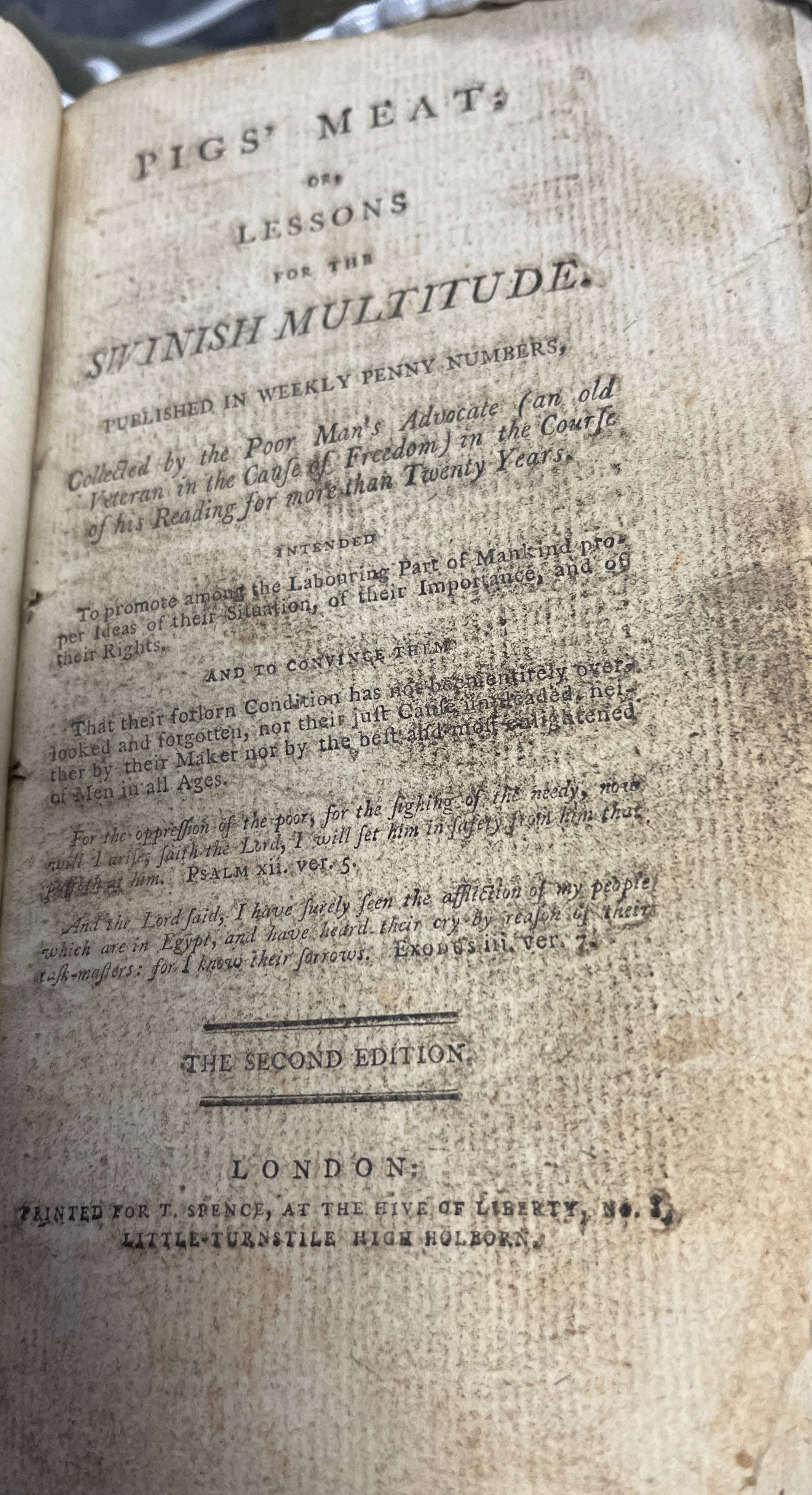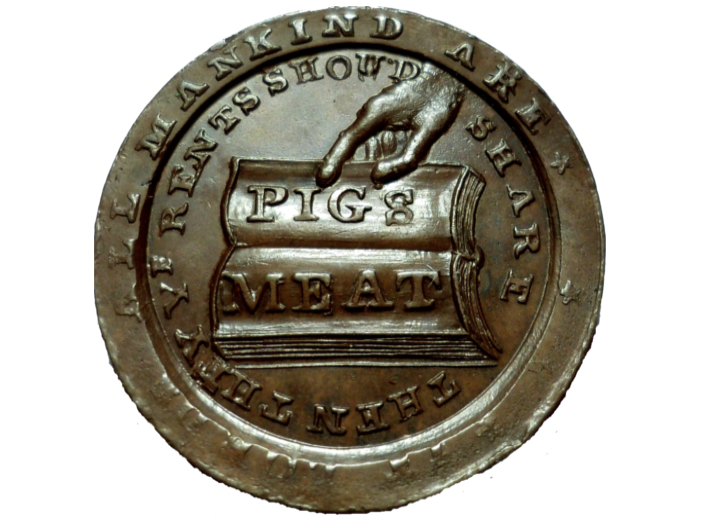On Twitter, I particularly enjoy following English Radical History (@EnglishRadical) which was created by Matthew Kidd. Its tweets introduce key figures and dates in radical history, as well as sharing short quotations from radical texts that often speak directly to contemporary affairs. In this last regard, @EnglishRadical is a modern reincarnation of the popular radical periodicals of the 1790s which sought to educate 'ordinary' readers by sharing short extracts from key political texts.
Title page of Thomas Spence’s Pig’s Meat: Or Lessons for the Swinish Multitude (London, 1793-1795). Image by Rachel Hammersley from the copy held at the Robinson Library, Newcastle University. Rare Books (RB 331.04 PIG). Reproduced with kind permission.
The best known of these publications were One Pennyworth of Pig's Meat; Or Food for the Swinish Multitude (1793-1795) produced by Thomas Spence and Hog's Wash; or a Salmagundy for Swine (1793-1795), later given the more prosaic title Politics for the People, which was the work of Daniel Isaac Eaton. The porcine references in the titles were not coincidental but a deliberate response to Edmund Burke's dismissive comment in Reflections on the Revolution in France that unless learning remained the preserve of the nobility and priesthood (as had traditionally been the case) it would be cast with them 'into the mire and trodden down under the hoofs of a swinish multitude' (Edmund Burke, Reflections on the Revolution in France. London, 1790, p. 117). Far from being cowed by this slight, Spence interpreted it as a challenge. The first issue of Pig's Meat, which appeared in September 1793, offered extracts that had been collected by the 'Poor Man's Advocate' (a title Spence had first adopted in the 1770s) over the previous twenty years. His aim, in making them available to the 'Labouring Part of Mankind', was to promote among them 'proper Ideas of their Situation, of their Importance, and of their Rights. And to convince them That their forlorn Condition has not been entirely overlooked and forgotten, nor their just Cause unpleaded, neither by their Maker nor by the best and most enlightened of Men in all Ages' (Thomas Spence, One Pennyworth of Pig's Meat. London, 1793, p. 1).
Edmund Burke from the studio of Sir Joshua Reynolds, c. 1769. National Portrait Gallery, NPG 655. Reproduced under a Creative Commons Licence.
The extracts offered in Pig's Meat were taken from a variety of texts. These ranged from relatively obscure pamphlets produced during the Interregnum, such as William Sprigge's A Modest Plea for an Equal Commonwealth Against Monarchy (1659), via standard commonwealth fare like John Trenchard and Thomas Gordon's Cato's Letters (1720-1723), to more recent radical commentary as in William Frend's Peace and Union (1793). The most frequently quoted author was James Harrington. Spence included excerpts from several of the works reprinted in John Toland's The Oceana of James Harrington, and his other works, and he stated explicitly in volume 1 that 'Portions of this Collection will frequently be inserted in the Course of this Publication' (Spence, Pig's Meat, p. 79). While the majority of excerpts were taken from prose pamphlets, the full range of genres on display was wide, with sermons, correspondence, travel literature, and even poems and songs all being included.
Title page of Politics for the People, or A Salmagundi for Swine (London, 1793-1795). Image by Rachel Hammersley from the copy held at the Robinson Library, Newcastle University. Special Collections (Friends 336-337). Reproduced with kind permission.
The extracts explored various themes including: free speech; constitutional reform; the oppression of the poor; and the superiority of republican over monarchical government. Many spoke obliquely to contemporary political events. For example, several considered the negative effects of war, particularly for the poor, a resonant (but also a controversial) issue at the height of the conflict with the French Republic. A key feature of Spence's periodical - which was advertised on the title page - was the fact that he included Biblical passages alongside secular texts. He was keen to demonstrate that the ideas he was advocating, in particular concern for the poor, could be found in the Bible itself. Moreover, the political authors cited included not just known radicals such as Joel Barlow, Richard Lewes, and Spence himself, but also more mainstream - even conservative - thinkers such as Jonathan Swift, Lord Lyttleton, and Samuel Pufendorf, who were cited in such a way as to draw out the radical implications of their arguments.
Just a few weeks after the first issue of Pig's Meat appeared, Eaton launched Hog's Wash, which was very similar in its approach and format. It too immediately drew attention to the Burkean inspiration. The epigram by 'Old Hubert' declared:
Since Times are bad, and solid food is rare;
The Swinish herd should learn to live on Air:
Acorns and Pease, alas! no more abound,
A feast of Words, is in the HOG TROUGH found.
The subtitle claimed that the work would consist:
Of the choicest Viands, contributed by the Cooks of the present day,
AND
Of the highest flavoured delicacies, composed by the Caterers of former Ages.
(Daniel Isaac Eaton, Hog's Wash, or A Salmagundy for Swine, London, 1793,
Titlepage).
Though the price was 2d (double that of Spence's periodical), it was still clearly aimed at ordinary folk. Alongside the sort of fare found in Pig's Meat, Eaton also made much use of fables designed to deliver moral messages. For example, at the beginning of the sixth issue he offers the tale 'Logs, Storks, and Asses' that he claims was written in 1694, soon after the Glorious Revolution. Its message was that even when the people choose their own king, they still tend to end up with a bad ruler who hinders, rather than benefits, his subjects.
Spence’s letter in Politics for the People. Image by Rachel Hammersley from the copy detailed above. Reproduced with permission.
The connection between Pig's Meat and Hog's Wash was more direct than just a similarity of purpose and format. Eaton's first issue opens with a letter addressed to him and dated 9th September 1793, which praises the publication. The letter's author expresses concern 'that the provision should be devoured faster than ever your unremitting exertions might be able to supply it' and so offers 'a few morsels from his own store of "Hog's Meat" (Eaton, Hog's Wash, p. 2). The passages that follow come from Lord Lyttleton's Persian Letters, excerpts from which had also appeared in the first volume of Pig's Meat. Moreover, the letter is signed 'A Brother Grunter', a pseudonym that Spence had previously used when writing to Eaton directly.
The first page of the first issue of John Marshall’s The Newcastle Christian Reformer’s Monthly Tract (Newcastle, 1821). Image by Rachel Hammersley from the copy at the Robinson Library, Newcastle University. Special Collections Edwin Clarke Local (Clarke 559). Reproduced with kind permission.
It was not only Eaton who was inspired by Spence's model, nor did such publications only flourish in London. In the 1790s Welsh-language versions quickly appeared. Similarly, in the 1820s a Newcastle printer, John Marshall, published The Newcastle Christian Reformer's Monthly Tracts in which religious and political texts were interspersed with fables. In January 1823 Marshall began publishing the Northern Reformer's Monthly Magazine. It comprised a range of political material and its purpose was reflected in this statement that appeared in the final issue:
The editors of this Magazine, during the short period of their labours endeavoured to enlighten and instruct their fellow countrymen on subjects closely connected with their interests and the common good; and have also exposed some of the grossest evils of the system of misgovernment under which we are, for some time longer, it is feared, doomed to suffer.
In many respects the zenith of this genre came with the publication in 1839 of William J. Linton's The National, which, as I noted in a previous blogpost, was subtitled A Library for the People. It provided readers with extracts from a wide range of texts, including a number that had appeared in the publications of Spence and Eaton - such as Swift, Harrington, Godwin, Milton, Voltaire and Rousseau. Indeed some passages were identical, suggesting that we can see here the creation of a canon of radical texts.
Though times (and methods) are very different today, the tradition does continue. On 2 July 2022 @Radical History commemorated the birth in 1750 of Thomas Spence with this tweet:













